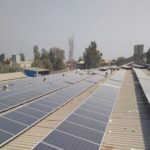How to Calculate Battery Capacity for Solar Off-Grid Applications
How to Calculate Battery Capacity for Solar Off-Grid Applications
Sizing a battery for off grid solutions is quite complex from overall system design point of view. If we oversize then we carry the risk of battery not being fully charged and if undersized then we run the risk of not servicing the intended load for the planned duration.
Batteries are used for off grid applications so that the energy stored in the batteries can then be used directly to power DC loads or it can be converted to A/C to power AC loads.
The recommended batteries should be of deep discharge higher cycle count type.
Sufficient information needs to be collected before we start to size the battery bank for any system. The key ingredients are –Kilo Watt Hours of electricity usage per day, Number of Days of Autonomy, Depth of Discharge limit for battery and Ambient temperature at battery bank storage place.
Electrical Usage in the premises: We need to list all the appliances in the premises and their consumption patterns like how much wattage and for how many hours and then tabulate the information to arrive at a total consumption on a per day basis. If you know the kilowatt hours (kWh) per day just multiply that number by 1,000 to determine the Watt-hours per day. (Example: 1.5 kWh = 1,500 Wh)
Days of Autonomy: Next, you must determine the number of days of battery back-up. This may depend upon the no of sun less days in your area. If you’re sizing a battery bank to be used in addition to an on-demand fuel-powered generator, the number of days of backup will represent the number of days you intend to go without using your generator.
Depth of Discharge: Another factor to consider is the planned Depth of Discharge (DoD) of your battery bank. Batteries are rated in terms of charge cycles and D-O-D. A single cycle takes a battery from its fully charged state, through discharge (use), then back to full charge via recharging. The (D-O-D) depth of discharge is the limit of energy withdrawal to which you will subject the battery (or battery bank). DoD is expressed as a percent of total capacity. The further you discharge a battery, the fewer cycles that battery will be capable of completing. Simply stated, deeper discharge shortens the life of the battery.
It’s recommended that one should never discharge a deep-cycle battery below 50% of its capacity; however, many battery manufacturers recommend even lesser DoDs. For off-grid applications, a 25% DoD will extend battery life significantly. On the other hand, if you’re only using the batteries occasionally, as a backup system, you can factor in a DoD of 50% or perhaps more. Number of cycles will determine the life of the battery.
Temperature: Battery life and capacity are affected by the temperature of the storage place of the batteries.
System Voltage: System voltages are typically 12V, 24V, or 48V.
Calculations for sizing the battery bank: Let’s go through the steps below, using the following example system:
- A system load of 5,000 Watt-hours per day
- Three Days of Autonomy (back up) needed
- Planned Depth of Discharge (DoD): 50%
- Battery bank ambient average low temperature 27 C.
- A 48V system
| S. No. | Process | Example |
| A | Identify daily usage in watt-hrs | 5000 Watt Hrs/Day |
| B | Identify sun less days at a stretch/days of autonomy. Multiply WH/Day by this no. | 3 sunless Days / Autonomy for 3 day ::5000X3=15000WH |
| C | Now D-O-D and convert from % to a decimal value and divide result of B above. | 50% D-O-D or 0.5=15000/0.5=30000WH |
| D | Now account for inverter efficiency which is 95-98.6% | 95% =300000/0.95=31578 WH |
Selecting batteries to meet the Amp-hour capacity: We have calculated the Ah required, we have to keep in mind that we should not put more than 3 batteries in parallel to get better life because if we string more than 3 batteries in parallel then in the likely event of uneven charging the life will reduce. We shall require at 48 v 31578/48 Ah.ie. 658 Ah batteries. We can have 4, 12 V, 658 ah batteries and connect them in series to get 48 V 625 Ah or else 8, 12 V, 312.5 Ah batteries and connect four in series and two rows in parallel or else any other combination. Just keep in mind that you can add voltage by series placement of batteries and to achieve current, you have to add in parallel.
Creating the Battery bank: Amps, then Volts Select a battery having Ah close to the one we need. If our requirement is higher the multiply the no of batteries to achieve the Ah capacity needed. Now having achieved the Ah needed, see the voltage of the batteries and to get the desired voltage (as in our case 48 V), check the voltage of the battery and if it is 12 v then multiply by 4 to get 48 v and so on.
This will give you the number of such batteries you would need in each series string.
The total number of individual batteries you will need to complete your battery bank will be the product of the number of strings needed to meet your Ah requirement and the number of batteries per string needed to meet your system voltage requirement.
Total # batteries in bank = (# series strings) X (# batteries per string) You can then compare your candidate battery banks against price, size and availability. Price will also depend on the warranty of the batteries on offer by the vendor.
Suggested Articles

Monitoring Services for Solar Plants by Smart Roof Solar to Maximize Performance and Efficiency
Smart Roof Solar provides advanced monitoring services for solar plants to ensure maximum performance and efficiency. With real-time data tracking and intelligent analytics, our monitoring solutions help detect issues early, reduce downtime, and enhance the overall energy yield of your solar system.

Higher Electricity Bills in Haryana as Fuel Surcharge Rises
Haryana consumers are facing higher electricity bills after the Haryana Electricity Regulatory Commission (HERC) approved a fuel surcharge hike for DHBVN and UHBVN areas. The increase reflects rising fuel and power purchase costs, directly impacting domestic, commercial, and industrial users across the state.

Choosing the Right Solar Panel: Complete Guide for India
Solar is among the fastest-growing industries in India. This is mainly because solar energy is not only renewable but is also attractive from a financial point of view.

Why Go Solar: A Complete Guide to Solar Power for Homes and Industries
Switching to solar energy offers significant savings and environmental benefits. This guide explains why going solar is a smart choice, covering financial incentives, reduced electricity bills, and positive impacts on the planet.

Financing made easy for the Rooftop Solar Projects
Switching to solar is easier than ever with flexible financing options. This guide explains how to fund your rooftop solar project through loans, subsidies, and government schemes to make clean energy more affordable and sustainable.

What Is an Array Junction Box in Solar PV Modules? | Complete Guide
The Array Junction Box (AJB) is a critical component in solar PV systems, connecting multiple solar modules and ensuring safe flow of electricity to the inverter. This blog explains what an AJB is, its key features, types, and why it is essential for both residential and commercial solar installations. Understand how AJBs protect your system from overload, short circuits, and environmental factors while maintaining optimal performance.

Should You Replace Solar Panels with Solar Shingles?
Discover how solar batteries store excess energy, maximize your solar system’s efficiency, and provide reliable power during outages. Learn about the types, benefits, lifespan, and maintenance tips to make the most of your solar investment.

Everything You Need to Know About Solar System Earthing
Power factor after solar installation often fluctuates due to system design and load patterns. Learn the key causes, challenges, and solutions for better efficiency.